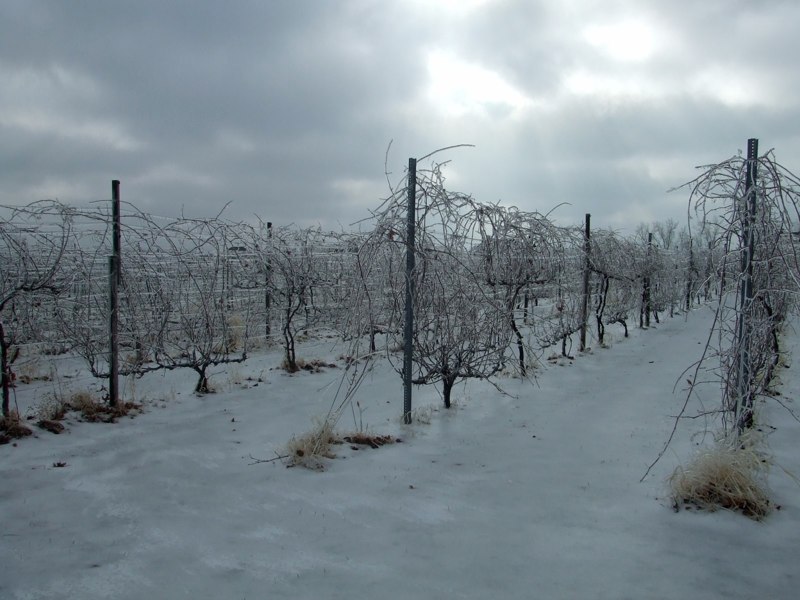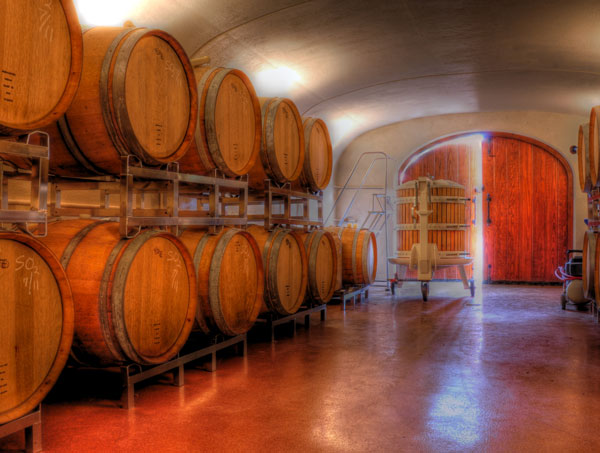Lower Midwest: Winter Impact on Vines and Budding Progress
Many growers of French hybrid and vinifera grapes across Kansas and parts of Missouri are confident that the long, cold winter has had little effect on their vines.
However, generally the cold weather has significantly delayed budding in lower Midwestern states. Some vineyards are not expecting bud break for many days, possibly weeks. 2014 is a stark contrast to 2012 when many Midwest vineyards were budding in mid-March.
See related story: Viticulture Advice For Warmest March Ever from MSU and UW Experts
Kansas
A few miles from Kansas City, at Holy-Field Vineyard & Winery, in Basehor, Kansas, the winter cold didn’t effect 30 acres of vines that include Norton, Chardonnel and Vignoles. When Michelle Meyer – who runs Holy-Field with father Les — spoke with MWP, it was mid-April but the vines were still dormant. ‘We’re glad about that” said Michelle Meyer as she reflected on a freeze in April 2007. The temperature dropped to 18 degrees after three weeks of 70 degree heat that caused a six-inch bud break. Many of the buds died.
Meyer said she hasn’t heard of anyone in Kansas who has significant winter damage to their vines, but wondered if vinifera growers in the area had suffered more than growers of French hybrids.
Dave Cairns at Vinland de la Cairns in Topeka, Kansas grows 3 acres of vinifera grapes that include Merlot, Cabernet-Sauvignon, Cabernet Franc and Pinot Noir. Cairns said it looks like they all survived the winter.
‘Everything is looking alright. I don’t think the freeze from the winter has hurt anything but we won’t really know until everything has budded,” said Cairns. ‘I’m optimistic at this point.” He used to put mulch down to stop roots from freezing but hasn’t done that for a few years and said he hasn’t noticed a difference.
‘We missed a lot of that really cold weather,” said Cairns, ‘Even Missouri got a lot of cold weather that we didn’t get, it kind of slid by us.”
Missouri
In Missouri, the man described by some as the godfather of Missouri Vinifera, Michael Amigoni, from Amigoni Urban Winery in Kansas City, said his vines have come through the cold winter very well. Temperatures at Amigoni’s vineyard dropped to -7F. ‘From our assessment of damage we believe we’ve got about 10-15% damage to primary buds,” he said. The most impacted vines are Cabernet Sauvignon and Petit Verdot. Amigoni said this is the first time the vines suffered during winter for several years.
‘We hill up our vinifera to prevent mortality of the vines,” he said. This method involves pushing up the soil around the base of the vine trunk to cover up to above the graft.
Amigoni added that if yields are significantly down due to primary bud loss, they will probably increase the quantity of grapes they purchase from out-of-state. He expects budding in about a week’s time.
At Stonehaus Farms & Vineyards, in Lee’s Summit, near Kansas City, they grow a combined 5.5 acres of Norton, Chambourcin and Vignoles. Brett Euritt, the operations manager said these grapes ‘aren’t even close” to budding and the same is true at their other off-site vineyards.
‘It is super-mega-slow this year on bud break,” said Euritt. He said the vines are showing some signs of winter damage and he expects about 20% primary bud loss, which he thought could be typical for much of the state. However, he said, some vineyards around Hermann, are looking at much worse primary bud loss.
Russell Pruett, owner of Jacob’s Vineyard & Winery in Kirksville, Missouri, said temperatures reached -20F during winter, but he hasn’t seen any winter damage on his 6 acres of vines that include Concord and Norton. ‘Our primary buds are looking good,” he added. ‘They are budded but the buds haven’t broken yet.”
Kentucky
In Kentucky, at Rock Springs Winery, in Grayson, the east of the state, Travis Harris, said the winter was, ‘really rough on the vines.” Normally they start trimming the vines in early March but this year it was so cold they only started early this month. Rock Springs grows a range of vinifera including Cabernet Sauvignon, Traminette, Cabernet Franc and Chardonnay. The Chardonnay suffered in the cold and Harris said they have 30% more die back that usual. Budding for these vinifera could be many days away.
Southern Illinois
In Southern Illinois, Brett Robling, owner and winemaker at Lasata Wines in Lawrenceville, grows a total of 8 acres of Chambourcin, Vidal Blanc, Seyval Blanc, Traminette, Norton and De Chaunac. He said the buds haven’t really started to swell yet, and, based on what he saw pruning, ‘we had minimal winter damage on most varieties, with the exception of Vidal Blanc which looks to have moderate damage but probably because they were weakened by powdery mildew last season.”
Southern Indiana
In Southern Indiana, the Foch buds are swelling at Creekbend Vineyard in Bloomington, which is owned and managed by Oliver Winery. Some other varieties, like Traminette, are still largely dormant. “It’s like a patient who’s been in a coma,” said Oliver Winery owner, Bill Oliver. “You don’t know the extent of the damage until the vines wake up.”
While Oliver expects some bud damage, he does not think the vines were seriously impacted by temperatures that got as low as -16F, a rare occurrence in Southern Indiana.
Oliver also grows several vinifera varietals including Pinot Gris and Cabernet Sauvignon. As of April 18th, vinifera vines have been lifted from underneath piles of straw and secured to trellis wires for this growing season.




